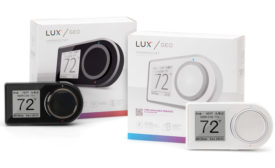Home » smart thermostats
Articles Tagged with ''smart thermostats''
Smart thermostats are among the most popular smart home wireless sensing products
Read More
European Utilities Partner with Smart T-Stat Manufacturers
Utilities could be a valuable partner for smart thermostat manufacturers in the US
Read More
WeatherBug App Gives Consumers Insight on How Weather Impacts Energy Use
Works with launch partners Honeywell, Nest, Samsung SmartThings, and Accelerated Innovations
October 6, 2015
Smart Thermostat Market Worth $5.9 Billion by 2020
It is expected to witness high growth in all applications, residential, commercial, and industrial
September 28, 2015
Survey Finds Americans Ready for the Smart Home
More than one in four Americans own smart home devices
September 17, 2015
Smart Thermostat Market to Reach $2.21 Billion by 2022
They have gained significant demand in North America and Europe
September 14, 2015
Opower and Nest Score Highest in Assessment of Home Energy Management Vendors
Opower offers leading suite of solutions, Nest expands its home energy management capabilities
September 8, 2015
Third Generation Nest Learning Thermostat Introduced
Thermostat saves 10 to 12 percent on heating bills and about 15 percent on cooling bills
September 1, 2015
Copyright ©2024. All Rights Reserved BNP Media.
Design, CMS, Hosting & Web Development :: ePublishing


